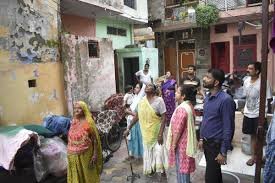A 4.4-magnitude earthquake rattled Delhi-NCR this morning, sending residents scrambling for safety and sparking a flurry of anxious posts on social media. The tremors, centered in Jhajjar, Haryana, struck at 9:04 AM IST, shaking homes, offices, and nerves across the capital and its neighboring cities. While no injuries or major damage were reported, the event has reignited concerns about Delhi’s readiness for a larger seismic event.
A Morning of Tremors

The quake hit without warning, its epicenter located 60 kilometers west of Delhi at a shallow depth of 10 kilometers, according to the National Center for Seismology (NCS). Residents from Noida to Gurugram, Faridabad to Ghaziabad, felt the ground sway for several seconds. In central Delhi, office workers described chandeliers swinging and coffee mugs rattling on desks.
Metro services screeched to a halt for a few minutes as a precaution, and videos of people evacuating high-rises flooded platforms like X. By noon, the Delhi Police and National Disaster Response Force (NDRF) confirmed no casualties or structural damage, calming initial fears.
Delhi’s Seismic Reality

Delhi’s location in Seismic Zone IV—a high-risk zone—makes it no stranger to earthquakes. The city sits near the Himalayan tectonic boundary, where the Indian and Eurasian plates collide, generating stress that can trigger quakes. Local fault lines, like the Sohna Fault and Delhi-Moradabad Fault, add to the risk. Just months ago, in February 2025, a 4.0-magnitude quake near Dhaula Kuan had residents on edge, and today’s event felt eerily familiar.
Experts warn that Delhi’s dense population and sprawling urban landscape amplify its vulnerability. “A 4.4-magnitude quake is minor, but it’s a wake-up call,” said Dr. Anil Kumar, a seismologist at the Indian Institute of Technology, Delhi. “If a stronger quake hits, many of our buildings—especially older ones—aren’t equipped to handle it.” The 1997 Vulnerability Atlas of India estimated that a high-intensity quake could damage over 85% of Delhi’s structures, a statistic that looms large as the city continues to grow vertically.
Infrastructure Under Scrutiny
As high-rises sprout across Gurugram and Noida, questions about construction standards are back in the spotlight. The Delhi Disaster Management Authority (DDMA) has long flagged unsafe building practices as a major concern. Many so-called “earthquake-resistant” structures meet only basic compliance, leaving doubts about their resilience in a major quake.
The NDRF, meanwhile, urged residents to stay prepared. “This was a minor event, but we can’t be complacent,” said NDRF spokesperson Vikram Singh. He recommended keeping emergency kits stocked with water, food, and first-aid supplies and practicing the “Drop, Cover, Hold On” drill: drop to your knees, cover your head under sturdy furniture, and hold on until the shaking stops.
Looking Ahead
Today’s earthquake, though mild, underscores the need for better preparedness in a city of over 20 million. The DDMA has promised to ramp up awareness campaigns and enforce stricter building codes, but experts say more needs to be done. Retrofitting older buildings, improving early warning systems, and educating residents could make all the difference if a bigger quake strikes.
For now, Delhi-NCR is breathing a sigh of relief. The tremors have faded, metro trains are back on track, and offices are humming again. But as the city settles into its usual rhythm, today’s shake-up is a stark reminder: in a region prone to quakes, vigilance is non-negotiable.
Last Updated on: Thursday, July 10, 2025 5:02 pm by Rishi Akkaraju | Published by: Rishi Akkaraju on Thursday, July 10, 2025 5:02 pm | News Categories: India
